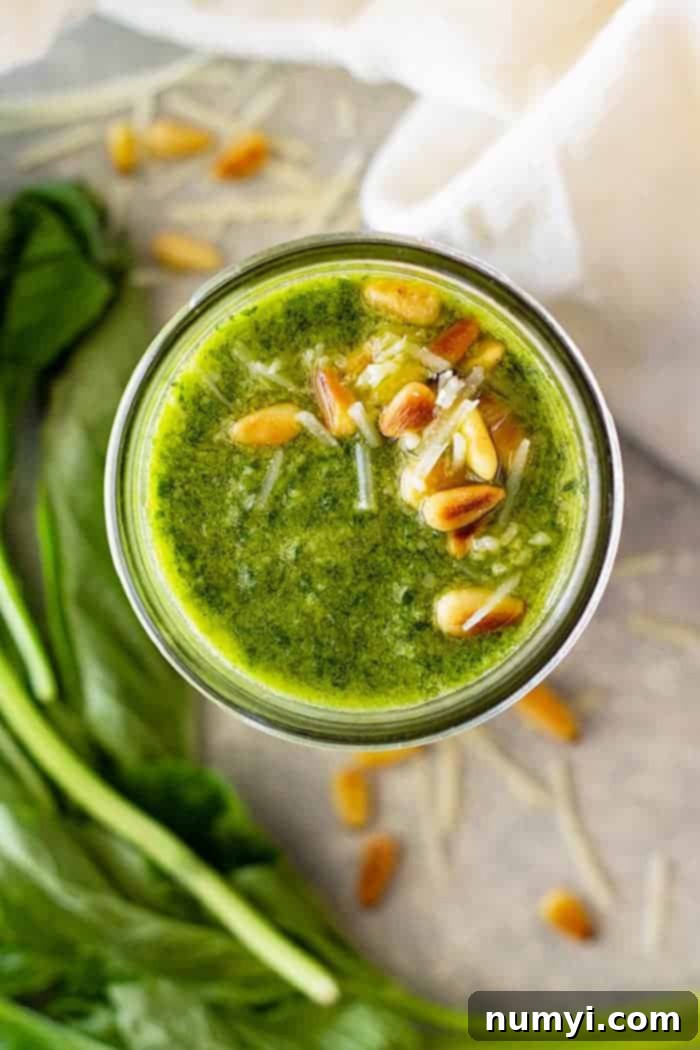Easy Homemade Basil Pesto Recipe: Your Complete Guide to Fresh, Flavorful Pesto
Discover how to make a classic basil pesto that’s miles better than store-bought. This guide covers everything from essential ingredients and simple steps to smart substitutions and perfect storage solutions, ensuring you enjoy fresh, vibrant flavor every time.
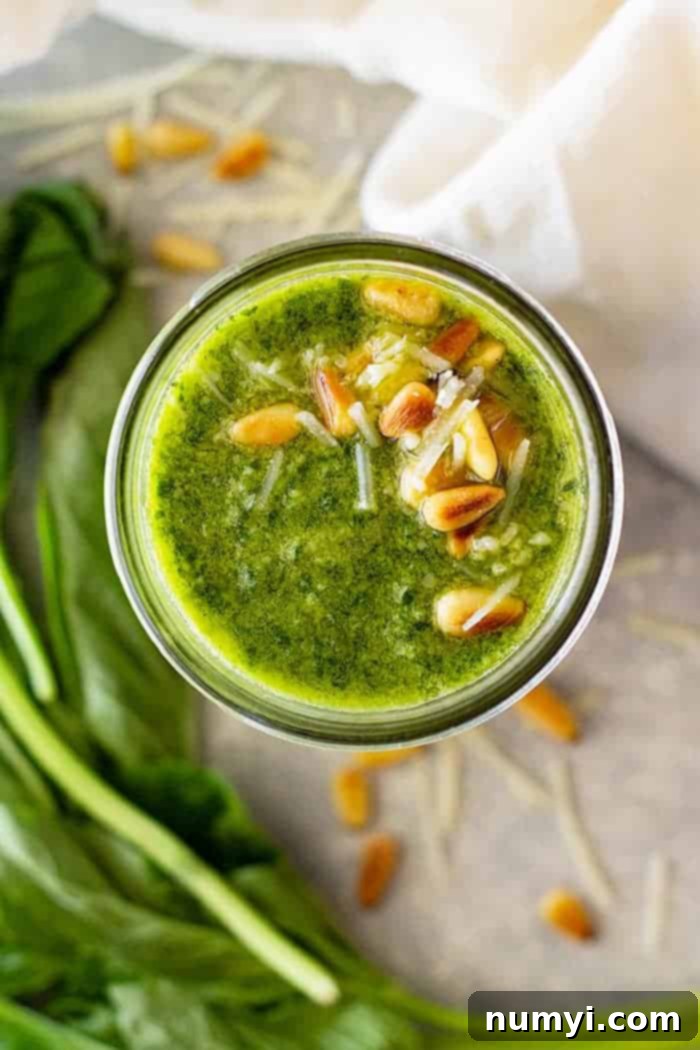
The Irresistible Allure of Homemade Basil Pesto
If you’ve never experienced the pure joy of homemade pesto, now is the time to add it to your culinary repertoire. Seriously, put it on your must-make list! For years, I was indifferent to pesto, often finding store-bought versions to be bland, oily, or just… lacking. That all changed the moment I whipped up my first batch from scratch. The difference is truly astounding; homemade basil pesto isn’t just better, it’s a revelation.
This isn’t just another recipe to try; it’s a foundational skill that will elevate countless dishes. It’s incredibly easy to make, and I can almost guarantee that once you taste the fresh, vibrant flavors of your own creation, you’ll never reach for that jarred stuff again. That’s a bold claim, perhaps, but one I stand by wholeheartedly! Like homemade Guacamole and Pico de Gallo, learning to make basil pesto at home is a game-changer that brings unparalleled freshness to your table.
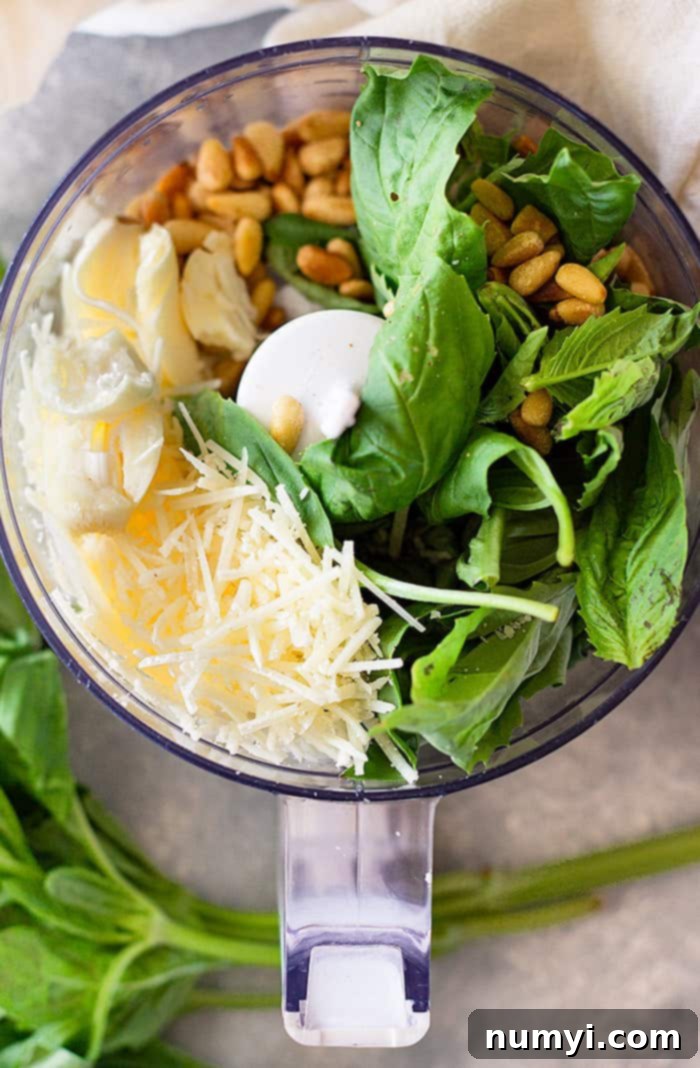
What Makes Homemade Pesto So Superior?
The secret to extraordinary pesto lies in its simplicity and the quality of its fresh ingredients. Unlike mass-produced versions, which often use cheaper oils, less vibrant basil, or even artificial flavorings, homemade pesto celebrates the natural goodness of each component. You control every aspect, from the robust flavor of your olive oil to the pungency of the garlic and the precise balance of salt.
When you make pesto at home, you capture the peak freshness of basil – its aromatic, slightly peppery, and sweet notes are intensified rather than muted. The vibrant green color is a testament to its freshness, a visual delight that hints at the burst of flavor to come. This fresh, unadulterated taste transforms simple pasta dishes, elevates sandwiches, and adds a gourmet touch to grilled meats and vegetables. It’s an artisanal creation from your very own kitchen, made with love and tailored precisely to your palate.
Key Ingredients for the Best Basil Pesto
Traditional basil pesto is a symphony of flavors and textures, typically crafted from fresh basil, Parmesan cheese, pine nuts, garlic, high-quality extra virgin olive oil, and a touch of salt. My preferred recipe includes a hint of lemon juice, which adds a bright zest and helps maintain the pesto’s vibrant green hue, but feel free to omit it if you prefer a more classic flavor profile.
Fresh Basil: The Aromatic Heart of Pesto
Basil is undeniably the star of this show. For the most authentic and flavorful pesto, opt for fresh, sweet basil leaves. If you’re lucky enough to have a thriving basil plant in your garden, this recipe is a fantastic way to utilize that abundant harvest! The leaves should be bright green, unbruised, and aromatic. If garden basil isn’t an option, you can easily find fresh basil at your local grocery store or farmer’s market. Wash the leaves thoroughly and pat them completely dry before using; excess water can dilute the flavor and affect the texture of your pesto.
For those who find the basil flavor a bit too strong, or who simply want to stretch their pesto, a clever substitution is to replace half of the basil with fresh spinach. This mellows out the intensity considerably while still allowing the essence of basil to shine through. It also adds extra nutrients and a lovely, slightly milder earthiness.
Pine Nuts: Creaminess and Subtle Sweetness
Pine nuts are a traditional component of pesto, lending a delightful creaminess and a subtle, slightly sweet, buttery flavor. However, they can often be quite expensive. If you’re looking for a more budget-friendly or simply an alternative option, blanched almonds make an excellent neutral-tasting substitute. Walnuts, cashews, or even sunflower seeds can also be used, each offering a slightly different flavor profile. For an extra layer of depth, lightly toast your pine nuts (or chosen alternative) in a dry pan over medium heat for a few minutes until fragrant. Be careful not to burn them!
Parmesan Cheese: Salty, Umami Balance
Parmesan cheese plays a crucial role in balancing the strong flavor of basil, adding a salty, sharp, and umami-rich dimension that brings all the ingredients together. While regular pre-grated Parmesan works, for the absolute best results, I highly recommend using freshly grated Parmigiano-Reggiano or Pecorino Romano. Parmigiano-Reggiano offers a nutty, complex flavor, while Pecorino Romano provides a saltier, tangier kick. Freshly grating your cheese ensures a superior texture and flavor that pre-grated versions simply can’t match.
Extra Virgin Olive Oil: The Liquid Gold
The quality of your extra virgin olive oil is paramount in pesto. This is not the time to skimp! A good quality extra virgin olive oil, derived from the first pressing of olives, contributes significantly to the pesto’s flavor, aroma, and silky texture. Look for cold-pressed varieties with a rich, fruity, or peppery note. The oil acts as a binder, emulsifying the ingredients into a smooth, luscious sauce. If you want to dive deeper into understanding olive oil, this insightful article from Bon Appetit is an excellent resource.
Garlic: The Aromatic Powerhouse
Garlic adds another essential dimension of flavor – a pungent, aromatic kick that enlivens the entire pesto. This is one ingredient I strongly advise against skipping! The amount of garlic is a matter of personal preference; two large cloves typically provide a balanced flavor, but feel free to add more if you love a bolder garlic presence. Its spicy, sharp notes cut through the richness of the oil and cheese, adding complexity.
Lemon Juice and Salt: Brightness and Seasoning
While traditional recipes don’t always include it, a squeeze of fresh lemon juice (2-3 tablespoons) brightens the pesto’s flavor and also helps prevent oxidation, keeping its vibrant green color longer. Always add salt to taste, remembering that Parmesan cheese also contributes significant salinity. Use fine sea salt or Kosher salt for best results.
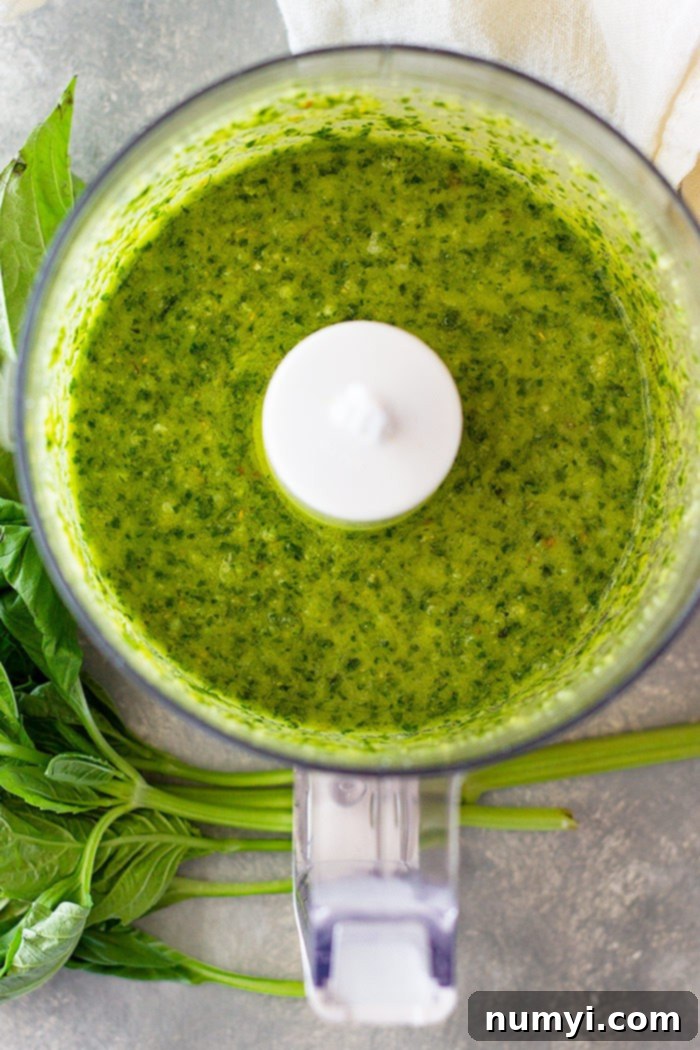
Why Does My Homemade Pesto Turn Brown? And How to Prevent It!
It’s a common dilemma: your beautifully vibrant green homemade pesto starts to turn an unappealing brownish color. This change is due to a natural chemical reaction called oxidation. Once basil leaves are cut and exposed to air, enzymes within the leaves react with oxygen, causing them to lose their bright green chlorophyll and turn brown. While the taste isn’t necessarily compromised, the visual appeal certainly is.
Fortunately, there are simple and effective ways to combat this:
- The Olive Oil Seal: This is arguably the most popular method. Before storing your pesto, transfer it to an airtight container and pour a thin, protective layer of extra virgin olive oil over the surface. The oil acts as a barrier, preventing air from reaching the pesto and initiating oxidation.
- The Plastic Wrap Press: An alternative method I often use is to press a piece of plastic wrap directly onto the surface of the pesto, ensuring there are no air pockets trapped between the pesto and the wrap. Then, seal the jar or container with its lid. This physical barrier effectively blocks oxygen.
- Lemon Juice Boost: As mentioned earlier, including a bit of fresh lemon juice in your pesto recipe (as I do) can also help. The acidity of the lemon juice acts as a natural antioxidant, slowing down the browning process.
By using one or a combination of these methods, you can keep your homemade basil pesto looking as fresh and vibrant as it tastes for longer.
How to Store Homemade Basil Pesto: Refrigeration and Freezing
Proper storage is key to extending the life and preserving the quality of your homemade basil pesto. Whether you plan to use it within a week or save it for months, these methods will ensure your pesto stays delicious.
Refrigeration: Short-Term Freshness
For immediate use, store your pesto in an airtight container in the refrigerator. To prevent browning, always cover the surface with a thin layer of olive oil or press plastic wrap directly onto the pesto before sealing the container. Stored this way, homemade basil pesto will remain fresh and vibrant for up to 1 week.
Freezing: Long-Term Convenience
Pesto freezes exceptionally well, making it perfect for meal prep or preserving a bountiful basil harvest. Here are a couple of popular methods:
- Ice Cube Tray Method:
- Pour the pesto into standard ice cube trays.
- Freeze for at least 2 hours, or until the pesto cubes are solid.
- Once frozen, remove the pesto cubes from the trays and transfer them to a freezer-safe bag or container.
- Store in the freezer for up to 3 months.
- A little note: Basil pesto’s strong pigments and oils may slightly stain your ice cube trays and leave a lingering pesto flavor. It might be wise to designate a separate set of trays specifically for pesto and other strong-flavored items.
- To use: Simply pop out a few cubes and let them thaw at room temperature or gently warm them.
- Baking Sheet Method:
- Line a small baking sheet with parchment paper.
- Spread the pesto in a thin, even layer across the parchment paper.
- Freeze until solid (a few hours).
- Once frozen, break the large pesto slab into smaller pieces or chunks.
- Transfer these pieces to a freezer-safe bag or container.
- Store in the freezer for up to 3 months. This method is great for larger batches and saves space if you have many small containers.
Freezing your pesto ensures you can enjoy the taste of summer basil even in the colder months, ready to be incorporated into any meal.
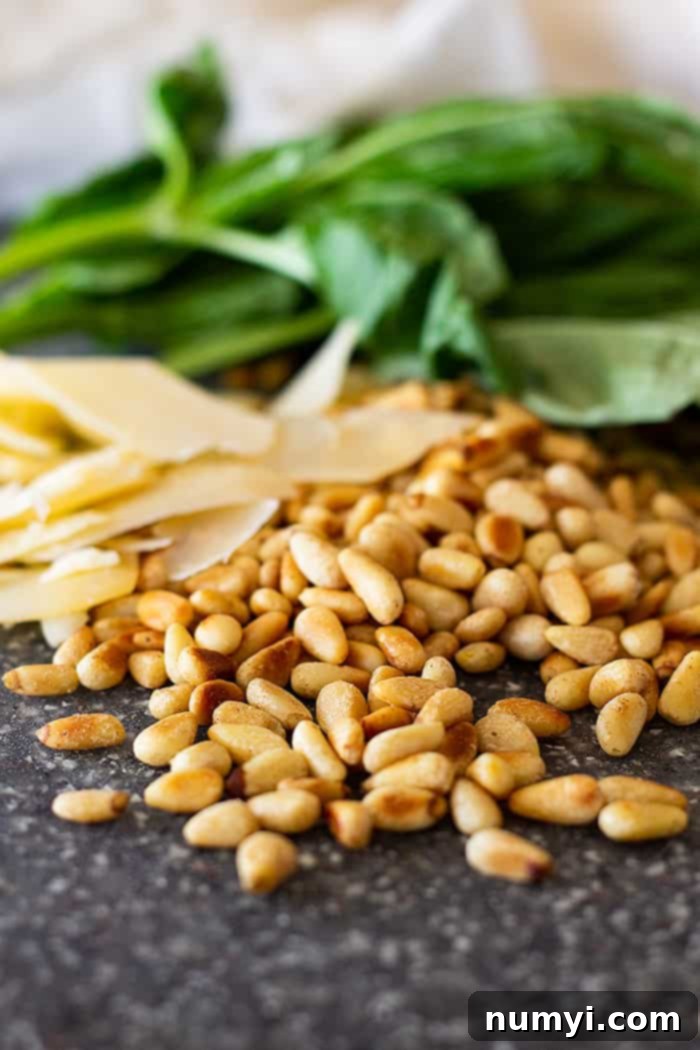
Creative Ways to Use Your Delicious Homemade Basil Pesto
The versatility of homemade basil pesto is one of its most appealing qualities. It’s not just for pasta! Once you have a batch of this vibrant green sauce on hand, a world of culinary possibilities opens up. Here are some fantastic ways to enjoy your homemade basil pesto:
- Pasta Perfection: The classic use! Stir a generous dollop into warm, cooked pasta, risotto, or tortellini. Add a splash of pasta water to create a silky, emulsified sauce that clings beautifully to every strand.
- Pizza Topping: Spread it as a flavorful base instead of (or in addition to) tomato sauce on your pizza, or dollop it over a traditional Margherita for an extra burst of fresh flavor.
- Elevated Crostini: Spread on toasted crostini and top with chopped ripe tomatoes, crumbled goat cheese, or thinly sliced prosciutto for an elegant appetizer.
- Sandwich & Wrap Spread: Mix with mayonnaise, cream cheese, or hummus to create a gourmet spread for sandwiches, wraps, or even a panino. It adds incredible depth to any lunch.
- Dip for Everything: Serve it as a dip for crackers, crusty bread, fresh vegetable sticks (carrots, celery, bell peppers), or even pita chips.
- Grilled Protein Enhancer: Spoon it over grilled chicken, fish, shrimp, or steak for an instant flavor upgrade. It’s particularly delicious with flaky white fish.
- Sauce Booster: Swirl a tablespoon or two into your favorite alfredo sauce or even a simple marinara sauce for an added layer of herbal freshness.
- Breakfast Brilliance: Fold it into scrambled eggs or an omelet for a sophisticated and flavorful breakfast or brunch.
- Roasted Vegetable Companion: Toss with roasted potatoes, zucchini, asparagus, or cherry tomatoes after cooking for a vibrant finish.
- Soup & Stew Swirl: Stir a spoonful into a bowl of minestrone, vegetable soup, or even tomato soup just before serving.
- Marinade Magic: Use it as a quick marinade for chicken, fish, or tofu before grilling or baking.
With homemade basil pesto, you’ll always have a secret weapon in your fridge (or freezer) to transform ordinary meals into extraordinary culinary experiences.
How to Make Basil Pesto

Ingredients
- 3 cups loosely packed fresh basil
- 2 large cloves garlic
- 1/2 cup extra virgin olive oil
- 1/4-1/3 cup grated Parmesan cheese
- 1/4 cup raw or toasted pine nuts
- 2-3 tablespoons fresh lemon juice
- salt to taste
Instructions
-
Combine all ingredients (fresh basil, garlic, extra virgin olive oil, Parmesan cheese, pine nuts, and fresh lemon juice) in a food processor. Pulse and blend until well combined and smooth, scraping down the sides as needed. Taste and add salt as needed, keeping in mind the Parmesan cheese is already salty.
-
To Store in the Refrigerator: Transfer the pesto to an airtight container. Pour a thin layer of extra virgin olive oil on top, or press a piece of plastic wrap directly onto the surface of the pesto to exclude air, then seal the container. Store in the refrigerator for up to 1 week.
To Freeze: You have two excellent options for freezing. Option 1 (Ice Cube Trays): Pour the pesto into ice cube trays and freeze for 2 hours or until solid. Once frozen, remove the pesto cubes from the tray and transfer them to a freezer-safe bag. Store in the freezer for up to 3 months. (Be aware that this method may slightly discolor your ice cube trays and leave a pesto flavor behind, so you might want to use separate trays for this purpose.) Option 2 (Baking Sheet): Line a small baking sheet with parchment paper and spread the pesto in a thin, even layer. Freeze until solid (a few hours), then break the frozen pesto into chunks and store in a freezer-safe bag in the freezer for up to 3 months.
-
Delicious Uses for Your Homemade Pesto: Stir into cooked pasta, risotto, or cooked tortellini for a quick and flavorful meal.
Try it as a vibrant base on homemade pizza or flatbread.
Spread on crostini topped with chopped tomatoes and goat cheese for an elegant appetizer.
Mix with mayo or cream cheese to create a delectable spread for sandwiches or wraps.
Use as a flavorful dip for crackers, crusty bread, or fresh vegetables.
Serve over grilled chicken, fish, or shrimp for a gourmet touch.
Add a spoonful to alfredo sauce or marinara to enhance their flavor.
Fold into scrambled eggs or an omelet for a sophisticated breakfast.
Nutrition
Final Thoughts on Mastering Homemade Pesto
Making homemade basil pesto is a simple yet profoundly rewarding culinary endeavor. It’s a versatile sauce that brings an unparalleled burst of fresh, herbaceous flavor to almost any dish. By understanding the key ingredients, embracing smart substitutions, and utilizing proper storage techniques, you can ensure your pesto is always at its best.
So, gather your fresh basil, fire up your food processor, and embark on this delicious journey. You’ll soon discover why homemade pesto is a staple in so many kitchens and why it truly tastes “so much better” than anything you can buy. Don’t be afraid to experiment with nut alternatives or a hint of lemon – make it your own! Share your creations and enjoy the vibrant taste of fresh, homemade perfection.
